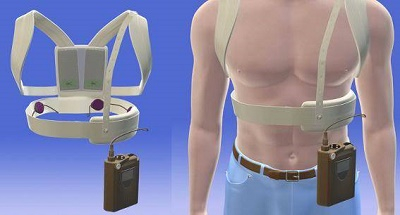The innovative and lightweight wearable cardioverter defibrillator (WCD) is specifically designed for patients with increased risks of sudden cardiac arrest (SCA). Wearing an external cardiac defibrillator allows physicians valuable time to assess long-term arrhythmic risk and activate appropriate health care plans.
The innovative and lightweight wearable cardioverter defibrillator (WCD) is specifically designed for patients with increased risks of sudden cardiac arrest (SCA). Wearing an external cardiac defibrillator allows physicians valuable time to assess long-term arrhythmic risk and activate appropriate health care plans.

The cardioverter defibrillator is an easy to wear shoulder strap permitting patients to return to their daily activities with additional protection from sudden cardiac death (SCD).
The non-invasive halter-style shoulder strap harness consists of a garment and a monitor. The garment is meant to be worn under clothing. Its function is detecting arrhythmias and delivering treatment shocks. Worn around the waist or using a shoulder strap, the monitor records abnormal arrhythmias.
WCD’s continuously monitor patients’ heart rhythms and delivers a treatment shock if a life-threatening rhythm is detected. Timely defibrillation typically takes less than a minute and often restores a normal heart rhythm. Timely defibrillation is the single most important factor in saving an SCA victim’s life.
The biggest advantage of wearing a cardioverter defibrillator is avoiding the need for bystander intervention. Incredibly, wearable cardioverter external defibrillators have a 98 percent first treatment shock success rate for resuscitating patients from SCA.
The WCD may be prescribed for patients at high risk of SCA following a heart attack, before or after bypass surgery or stent placement, as well as for those with cardiomyopathy or congestive heart failure that places them at particular risk.
The WCD is a therapeutic option, listed along with implantable cardioverter defibrillators (ICDs), in the ACC/AHA/ESC Guidelines for the Management of Patients with Ventricular Arrhythmias and the Prevention of Sudden Cardiac Death. It is also a Class I recommendation in the International Society for Heart and Lung Transplantation Guidelines for the Care of Cardiac Transplant Candidates.




Share on social media